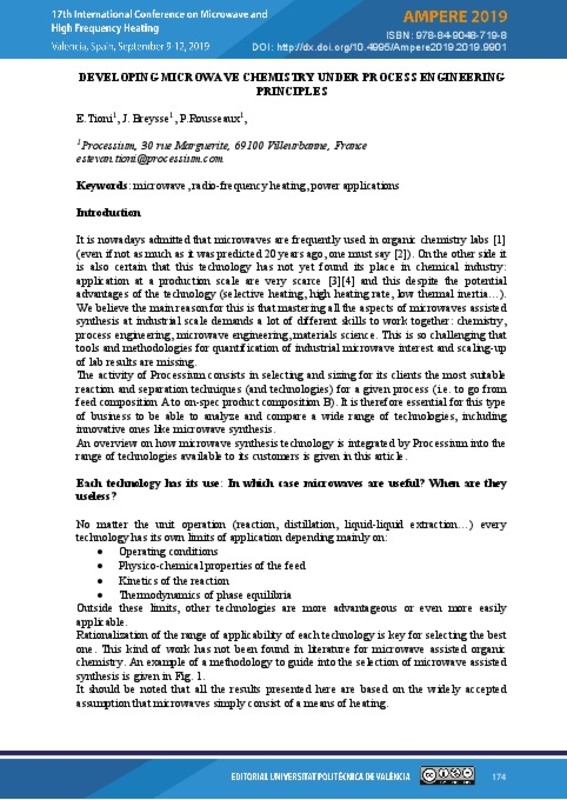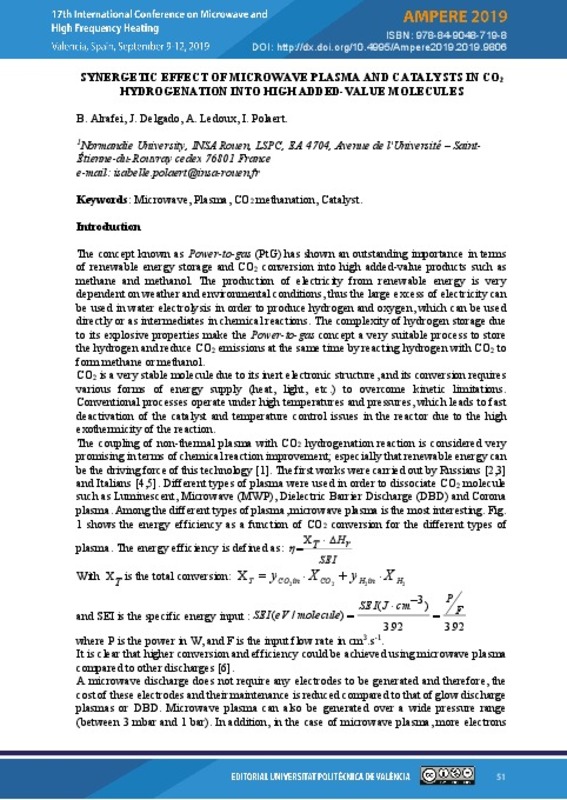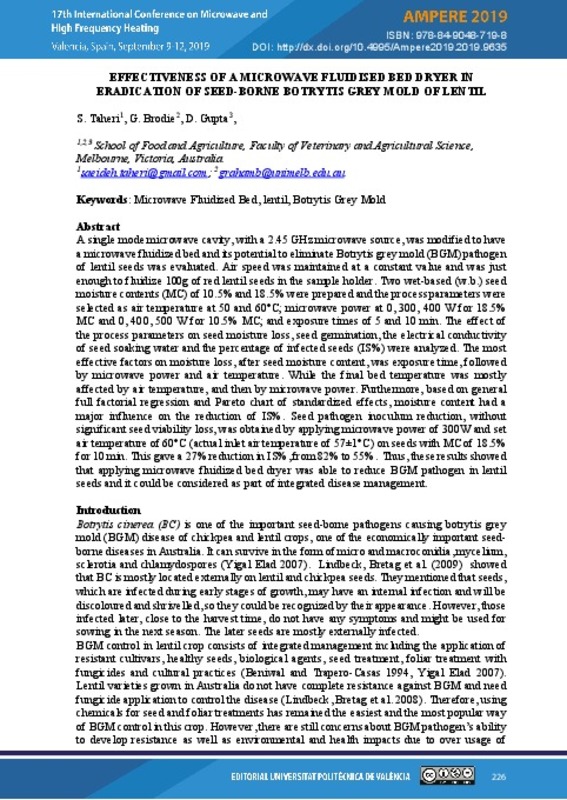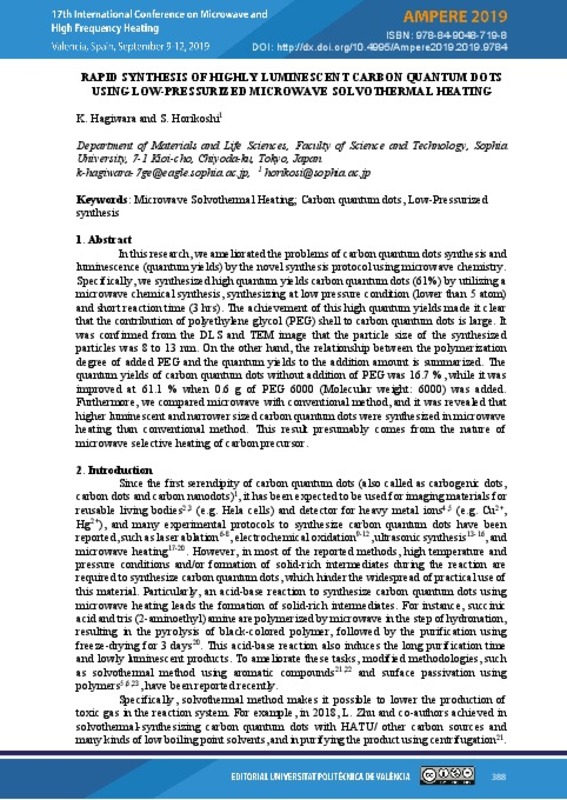JavaScript is disabled for your browser. Some features of this site may not work without it.
Buscar en RiuNet
Listar
Mi cuenta
Estadísticas
Ayuda RiuNet
Admin. UPV
Developing microwave chemistry under process engineering principles
Mostrar el registro sencillo del ítem
Ficheros en el ítem
| dc.contributor.author | Tioni, Estevan
|
es_ES |
| dc.contributor.author | Breysse, J.
|
es_ES |
| dc.contributor.author | Rousseaux, Pascal
|
es_ES |
| dc.date.accessioned | 2019-11-13T11:18:00Z | |
| dc.date.available | 2019-11-13T11:18:00Z | |
| dc.date.issued | 2019-10-15 | |
| dc.identifier.isbn | 9788490487198 | |
| dc.identifier.uri | http://hdl.handle.net/10251/130904 | |
| dc.description.abstract | [EN] It is nowadays admitted that microwaves are frequently used in organic chemistry labs [1] (even if not as much as it was predicted 20 years ago, one must say [2]). On the other side it is also certain that this technology has not yet found its place in chemical industry: application at a production scale are very scarce [3][4] and this despite the potential advantages of the technology (selective heating, high heating rate, low thermal inertia…). The point is that mastering all the aspects of microwaves assisted synthesis at industrial scale demands a lot of different skills to work together: chemistry, process engineering, microwave engineering, materials science. This is so challenging that tools and methodologies for quantification of industrial microwave interest and scaling-up of lab results are missing. In this work we present our contributions to the deployment of microwaves for synthesis in the chemical industry which are mainly The development of small pilot reactors (1 L) in stainless steel, capable to withstand temperature and pressureThe application of a chemical engineering methodology to microwave assisted synthesisAn example of intensification (see table) of an industrially interesting reaction using microwave to access NPW (high temperature and pressure)A tentative of rationalization of process criteria to identify a priori the interest of microwave heating for a specific application [1]. Diaz-Ortiz et al., Chem. Rec. 2019, 19, 85–97 [2]. Kappe, Chem. Rec. 2019, 19, 15–39 [3]. Aldivia, brevet WO2004/066683A1 [4]. https://cen.acs.org/articles/94/i36/Microwaving-ton.html | es_ES |
| dc.format.extent | 7 | es_ES |
| dc.language | Inglés | es_ES |
| dc.publisher | Editorial Universitat Politècnica de València | es_ES |
| dc.relation.ispartof | AMPERE 2019. 17th International Conference on Microwave and High Frequency Heating | es_ES |
| dc.rights | Reconocimiento - No comercial - Sin obra derivada (by-nc-nd) | es_ES |
| dc.subject | Energy Production by Microwaves | es_ES |
| dc.subject | Microwave CVD | es_ES |
| dc.subject | EM Modelling | es_ES |
| dc.subject | Microwave Material interaction | es_ES |
| dc.subject | Dielectric Properties | es_ES |
| dc.subject | Dielectric Properties Measurement | es_ES |
| dc.subject | Solid State Microwave | es_ES |
| dc.subject | Microwave Processing | es_ES |
| dc.subject | Microwave Chemistry | es_ES |
| dc.subject | Microwave applicators design | es_ES |
| dc.title | Developing microwave chemistry under process engineering principles | es_ES |
| dc.type | Capítulo de libro | es_ES |
| dc.type | Comunicación en congreso | es_ES |
| dc.identifier.doi | 10.4995/AMPERE2019.2019.9901 | |
| dc.rights.accessRights | Abierto | es_ES |
| dc.description.bibliographicCitation | Tioni, E.; Breysse, J.; Rousseaux, P. (2019). Developing microwave chemistry under process engineering principles. En AMPERE 2019. 17th International Conference on Microwave and High Frequency Heating. Editorial Universitat Politècnica de València. 174-180. https://doi.org/10.4995/AMPERE2019.2019.9901 | es_ES |
| dc.description.accrualMethod | OCS | es_ES |
| dc.relation.conferencename | Ampere 2019 | es_ES |
| dc.relation.conferencedate | Septiembre 09-12,2019 | es_ES |
| dc.relation.conferenceplace | Valencia, Spain | es_ES |
| dc.relation.publisherversion | http://ocs.editorial.upv.es/index.php/AMPERE2019/AMPERE2019/paper/view/9901 | es_ES |
| dc.description.upvformatpinicio | 174 | es_ES |
| dc.description.upvformatpfin | 180 | es_ES |
| dc.type.version | info:eu-repo/semantics/publishedVersion | es_ES |
| dc.relation.pasarela | OCS\9901 | es_ES |
Este ítem aparece en la(s) siguiente(s) colección(ones)
-
Ampere 2019 [66]











